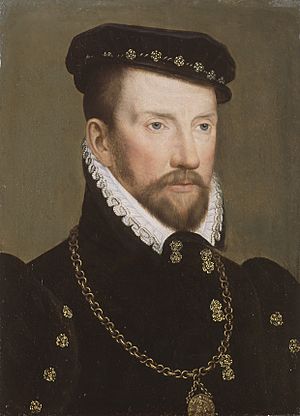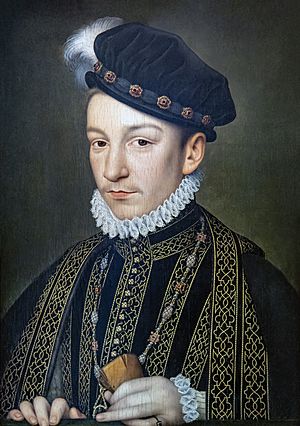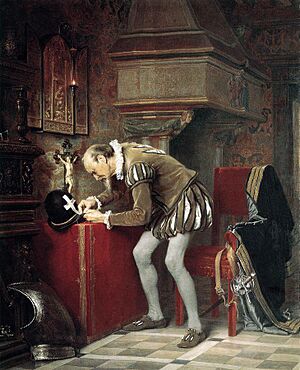St. Bartholomew's Day massacre facts for kids
The St. Bartholomew's Day massacre (French: Massacre de la Saint-Barthélemy) was a terrible event in 1572. It involved a series of planned killings and a wave of violence by Catholic mobs against the Huguenots. Huguenots were French Protestants who followed the teachings of John Calvin. This happened during the French Wars of Religion.
Many people believe Queen Catherine de' Medici, the mother of King Charles IX of France, started the massacre. It began a few days after her daughter Margaret of Valois married the Protestant King Henry III of Navarre on August 18. Many rich and important Huguenots had come to Paris, a mostly Catholic city, for the wedding.
The killings started on the night of August 23–24, 1572. This was just two days after someone tried to kill Admiral Gaspard II de Coligny, a main Huguenot leader. King Charles IX ordered some Huguenot leaders, including Coligny, to be killed. But the violence quickly spread throughout Paris. It lasted for several weeks and moved into the countryside and other cities. Experts today think between 5,000 and 30,000 people died across France.
This massacre changed the French Wars of Religion. The Huguenot political movement became much weaker because many of its important leaders were lost. Many ordinary Huguenots then changed their religion. Those who remained became more determined to fight. This event was one of the worst religious massacres of that century. Across Europe, it made Protestants believe that Catholicism was a cruel and untrustworthy religion.
Contents
Why it Happened
The St. Bartholomew's Day massacre happened because of several important events:
- The Peace of Saint-Germain-en-Laye ended the third War of Religion in August 1570.
- The marriage between Henry III of Navarre and Margaret of Valois on August 18, 1572.
- The failed attempt to kill Admiral de Coligny on August 22, 1572.
Peace and Marriage Problems
The Peace of Saint-Germain ended three years of civil war between Catholics and Protestants. But this peace was not strong. Many strict Catholics did not accept it. The powerful Catholic Guise family was not in favor at the French court. Admiral Gaspard II de Coligny, the Huguenot leader, was allowed back into the king's council in September 1571.
Strong Catholics were upset that Protestants were returning to the court. But Queen Mother Catherine de' Medici and her son, King Charles IX of France, supported the peace and Coligny. They knew the kingdom had money problems. They also knew the Huguenots were in a strong position. Huguenots controlled important towns like La Rochelle and Montauban.
To make the peace stronger, Catherine planned to marry her daughter Margaret of Valois to the Protestant Henry of Navarre. He would later become King Henry IV of France. This royal marriage was set for August 18, 1572. But traditional Catholics and even the Pope did not approve. The Pope and King Philip II of Spain both strongly criticized Catherine's plan to include Huguenots.
Tension in Paris
The upcoming marriage brought many important Protestants to Paris. But Paris was a city strongly against Huguenots. Parisians were usually very strict Catholics and did not like the Protestants being there. Catholic preachers encouraged their anger. People were horrified that a French princess was marrying a Protestant. The local government's opposition and the court's absence from the wedding made political tensions worse.
Adding to this bad feeling, harvests had been poor, and taxes had gone up. Higher food prices and the fancy royal wedding made common people even more tense. One specific problem was a cross put up where a Huguenot's house used to be. This Huguenot, Philippe de Gastines, had been executed in 1569. The mob had torn down his house and put up a large wooden cross. The peace agreement said the cross had to be removed. After much public resistance, it was moved in December 1571. This had already caused about 50 deaths in riots and property damage. During the August massacres, relatives of the Gastines family were among the first killed by the mob.
The royal court itself was very divided. Catherine had not gotten the Pope's permission for this unusual marriage. So, French church leaders were unsure what to do. It took all of the Queen Mother's skill to convince the Cardinal de Bourbon to marry the couple. Also, rivalries between leading families started again. The Guise family did not want to lose power to their rivals, the House of Montmorency. François de Montmorency, the governor of Paris, could not control the unrest in the city. On August 20, he left Paris.
Attempted Killing of Admiral de Coligny
After the wedding of Catholic Marguerite de Valois and Huguenot Henry de Navarre on August 18, 1572, Coligny and other Huguenot leaders stayed in Paris. They wanted to discuss some issues about the Peace of St. Germain with the king.
Someone tried to kill Coligny a few days later, on August 22. He was shot from an upstairs window as he walked home from the Louvre palace. He was badly hurt. The person who shot him, likely Charles de Louviers, Lord of Maurevert, escaped in the confusion.
There are three main ideas about who was truly behind the attack:
- The Guise Family: The Charles, Cardinal of Lorraine and his nephews, the Dukes of Guise and Claude, Duke of Aumale, are the most likely suspects. They were leaders of the Catholic party. They wanted revenge for the death of the two dukes' father, Francis, Duke of Guise. They believed Coligny had ordered his killing ten years earlier. The shot at Admiral de Coligny came from a house owned by the Guise family.
- The Duke of Alba: He governed the Netherlands for King Philip II of Spain. Coligny planned to lead a military campaign in the Netherlands to help free the region from Spanish control. Coligny had secretly sent troops to help Protestants in Mons, who were now surrounded by the Duke of Alba's forces. So, Admiral de Coligny was a real threat to the Duke of Alba.
- Catherine de' Medici: Many believe the Queen Mother was worried that the king was listening too much to Coligny. Catherine reportedly feared that Coligny's influence would pull France into a war with Spain over the Netherlands.
Coligny was killed a few days later, becoming one of the first victims of the massacre.
The Massacres Begin

The killings started on the night of August 23–24, 1572. The violence spread quickly through Paris. Catholic mobs attacked Huguenots in their homes and on the streets. The massacre continued for several weeks. It spread from Paris to other towns and the countryside.
How Many Died?
It's hard to know exactly how many people died. Estimates range from 2,000 to 70,000. Modern historians give figures from about 5,000 to 30,000 across France. For example, some estimates say about 2,000 died in Paris and 3,000 in other areas. Other estimates suggest around 10,000 total, with 3,000 in Paris and 7,000 in the provinces. Some historians even suggest up to 20,000 or 30,000 total.
Among those killed were the philosopher Petrus Ramus and the composer Claude Goudimel.
See also
- Michelade, a massacre of Catholics by Protestants in Nîmes in 1567




